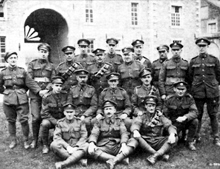War in Peace

Company 6 of the Royal Canadian Engineers dug tunnels at Vimy Ridge, patched up roads near Amiens and defused mines after the war. Here the company's non-commission officers pose in Belgium four months after the Armistice. Department of National Defense / Library and Archives Canada / PA - 4149)
I'll never forget the first night. I stayed out most of the night, watching the flares go up over No Man's Land, like fireworks, and hearing the cannons and bursts of rifle and machine-gun fire.
Sam Glode joined the CEF at the age of 35, enticed by the security of regular pay, plus food and clothes.44 Before the war began, this Mi' kmaq from Nova Scotia had been a lumberjack, as well as a hunting and fishing guide. In 1915, he became an infantry soldier and soon after, assumed a new occupation, as a Royal Canadian Engineer (RCE) in Belgium and France.
For most of the Great War, Glode served with a tunnelling company of the 6th Field Company and Battalion, RCE. The company dug tunnels in Belgium, carved dugouts at Vimy Ridge and patched up roads near Amiens. When the Armistice was announced, Glode was back in Belgium, about to earn the DCM.
Although the war had officially ended, Allied soldiers were still active. The Canadian Corps was advancing toward Germany, where it would later assume occupation duties. Corporal Glode's company was in the lead, searching for mines and demolition charges.
On the 19th and 20th of November, Glode personally removed 450 charges. His DCM citation states, "He showed great devotion to duty and an utter disregard of personal danger."
Sam Glode returned to Nova Scotia in the spring of 1919 and resumed his hunting and guiding occupations. He died at Camp Hill Hospital in Halifax in 1957.
- Date modified: